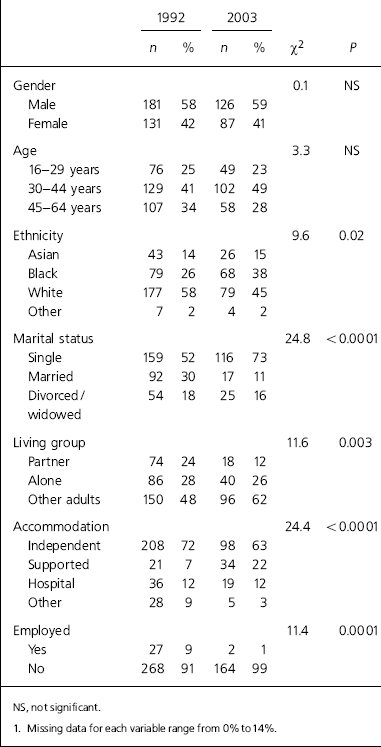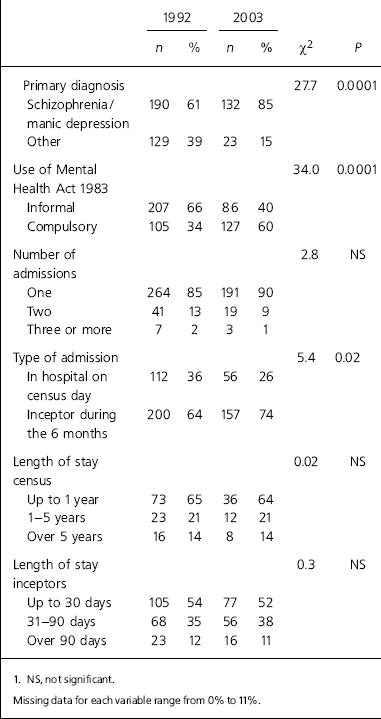North Birmingham spearheaded the introduction of functionalised community psychiatric services in the UK (Reference Minghella, Ford and FreemanMinghella et al, 1998). In this model generic multidisciplinary community mental health teams were superseded by specialised home treatment, assertive outreach, rehabilitation and recovery and primary care liaison teams. This approach has since been adopted as national policy in the UK (Department of Health, 2000, 2001) and is presently being implemented throughout the country (Department of Health, 2004). Although there have been studies of the efficacy of both home treatment and especially assertive community treatment teams (albeit mostly in the USA), there has been surprisingly little evaluation of the effectiveness of comprehensive functionalised community services in everyday practice and controversy surrounds their promotion (Reference Thornicroft, Becker and HollowayThornicroft et al, 1999). It is important to determine whether this model can be applied successfully in ordinary clinical settings and in particular whether gains with regard to reduced bed usage are sustained.
Method
The study design takes the form of a before-and-after comparison. In 1992, a series of surveys were initiated to enumerate psychiatric morbidity in the adult population living in the west of Birmingham (Reference Commander, Daran and OdellCommander et al, 1997), a deprived ethnically diverse inner-city area (Reference Smith, Sheldon and MartinSmith et al, 1996). This included the gathering of comprehensive information on the use of in-patient care. These data offer an opportunity to evaluate the impact of a functional model (and especially home treatment and assertive outreach teams) on admission to psychiatric hospital. The services in west Birmingham were reconfigured between 1995 and 2000 and the new functionalised teams were well established at the time of the second phase of data collection. The changes were routinely introduced across the whole of the Northern Birmingham Mental Health Trust, which in total covered a population of over half a million.
All people aged between 16 and 64 years and resident in one of eight Birmingham electoral wards (Aston, Handsworth, Soho, Sandwell, Oscott, Kingstanding, Perry Barr and Ladywood) were eligible. The baseline data were collected for patients in hospital on 23 March 1992 (census) and those subsequently admitted during the following 6 months (inceptors) up to 22 September 1992. The same time period was studied in 2003. All relevant in-patient wards were screened on a weekly basis according to the age and residency criteria. These data were checked against the information gathered by the medical records department. A simple pro forma was used to facilitate the collection of demographic and clinical data from ward staff and case records of people admitted during the 6-month period. Data were analysed using the Statistical Package for the Social Sciences, version 12.0.1 for Windows and levels of significance assessed using the χ2 test.
Results
The number of patients in hospital during the 6 months fell from 312 in 1992 to 213 by 2003. The distribution by age and gender was unchanged (Table 1). The proportion of patients identified as Black, single, living with other adults, in supported accommodation and unemployed increased, as did the percentage with diagnoses of schizophrenia or manic depression (Table 2). A significantly higher percentage of patients from the Black ethnic group received one of the latter diagnoses both in 1992 (87% compared with 47% Asian and 53% White; χ2=31.8, P<0.0001) and 2003 (97% compared with 86% Asian and 72% White; χ2=15.6, P<0.0001).
Table 1. Demographic details of the patients1

| 1992 | 2003 | |||||
|---|---|---|---|---|---|---|
| n | % | n | % | χ 2 | P | |
| Gender | 0.1 | NS | ||||
| Male | 181 | 58 | 126 | 59 | ||
| Female | 131 | 42 | 87 | 41 | ||
| Age | 3.3 | NS | ||||
| 16-29 years | 76 | 25 | 49 | 23 | ||
| 30-44 years | 129 | 41 | 102 | 49 | ||
| 45-64 years | 107 | 34 | 58 | 28 | ||
| Ethnicity | 9.6 | 0.02 | ||||
| Asian | 43 | 14 | 26 | 15 | ||
| Black | 79 | 26 | 68 | 38 | ||
| White | 177 | 58 | 79 | 45 | ||
| Other | 7 | 2 | 4 | 2 | ||
| Marital status | 24.8 | <0.0001 | ||||
| Single | 159 | 52 | 116 | 73 | ||
| Married | 92 | 30 | 17 | 11 | ||
| Divorced/widowed | 54 | 18 | 25 | 16 | ||
| Living group | 11.6 | 0.003 | ||||
| Partner | 74 | 24 | 18 | 12 | ||
| Alone | 86 | 28 | 40 | 26 | ||
| Other adults | 150 | 48 | 96 | 62 | ||
| Accommodation | 24.4 | <0.0001 | ||||
| Independent | 208 | 72 | 98 | 63 | ||
| Supported | 21 | 7 | 34 | 22 | ||
| Hospital | 36 | 12 | 19 | 12 | ||
| Other | 28 | 9 | 5 | 3 | ||
| Employed | 11.4 | 0.0001 | ||||
| Yes | 27 | 9 | 2 | 1 | ||
| No | 268 | 91 | 164 | 99 | ||
Table 2. Clinical and service details1

| 1992 | 2003 | |||||
|---|---|---|---|---|---|---|
| n | % | n | % | χ 2 | P | |
| Primary diagnosis | 27.7 | 0.0001 | ||||
| Schizophrenia/manic depression | 190 | 61 | 132 | 85 | ||
| Other | 129 | 39 | 23 | 15 | ||
| Use of Mental | 34.0 | 0.0001 | ||||
| Health Act 1983 | ||||||
| Informal | 207 | 66 | 86 | 40 | ||
| Compulsory | 105 | 34 | 127 | 60 | ||
| Number of admissions | 2.8 | NS | ||||
| One | 264 | 85 | 191 | 90 | ||
| Two | 41 | 13 | 19 | 9 | ||
| Three or more | 7 | 2 | 3 | 1 | ||
| Type of admission | 5.4 | 0.02 | ||||
| In hospital on census day | 112 | 36 | 56 | 26 | ||
| Inceptor during the 6 months | 200 | 64 | 157 | 74 | ||
| Length of stay census | 0.02 | NS | ||||
| Up to 1 year | 73 | 65 | 36 | 64 | ||
| 1-5 years | 23 | 21 | 12 | 21 | ||
| Over 5 years | 16 | 14 | 8 | 14 | ||
| Length of stay inceptors | 0.3 | NS | ||||
| Up to 30 days | 105 | 54 | 77 | 52 | ||
| 31-90 days | 68 | 35 | 56 | 38 | ||
| Over 90 days | 23 | 12 | 16 | 11 | ||
Between 1992 and 2003 there was a significant increase (21%) in the proportion of patients detained in hospital compulsorily under the Mental Health Act 1983 (Table 2). A greater proportion of patients from the Black ethnic group were detained compulsorily both in 1992 (65% v. 26% Asian and 22% White; χ 2 =46.9, P<0.0001) and 2003 (79% v. 62% Asian and 42% White; χ2 =20.9, P<0.0001). There was no change in the number of admissions by each patient and neither the length of stay for patients in hospital on the census day nor for those subsequently admitted (mean=42 days, s.d.=41 in 1992 and mean=40 days, s.d.=36 in 2003) differed significantly between the two time periods (Table 2).
Discussion
There are obvious limitations in the study design, factors other than the highlighted service initiatives potentially accounting for the findings. Although there was little change in the adult population in west Birmingham over the decade considered (1991/2001 national census), variation in community morbidity cannot be discounted as an explanation, especially given concerns about the emergent impact of substance misuse on the use of in-patient services (Reference Lelliot and AudiniLelliot & Audini, 2003). The unique challenges facing deprived inner-city areas should not be underestimated (Reference KiselyKisely, 1998). Furthermore, it must be noted that a nascent home treatment service was up and running in two electoral wards at the time of the baseline survey (with five patients on its case-load on the census day in 1992) and may have had some impact on admissions. The data were collected solely from staff and case notes (and, for example, omitted information on bed numbers, staffing levels and service costs). Consequently, the variables were few in number, unrefined and in a sizeable minority of cases missing. These caveats aside, the changing use of in-patient care demonstrated here warrants consideration given the relevance to national policy (Department of Health, 2000).
The reduction by one-third of people in hospital can be contrasted with Smyth and Hoult's (Reference Smyth and Hoult2000) projection that home treatment is feasible for 80% of people conventionally requiring admission. The same authors contend that studies of home treatment show a reduction in admissions of 66% and propose a very pessimistic calculation of 55%. The present findings are at odds with these estimates but go beyond the 9% reduction of finished in-patient episodes for those with mental illness seen across the UK between 1991 and 1992 and 2001 and 2002 (details avalable from the National Statistics Statbase at http://www.statistics.gov.uk/STATBASE/ssdataset.asp). Contrary to expectations, there was no reduction in length of stay of patients in hospital, yet neither was there evidence that the fall in admissions was associated with an increase in readmissions. The decrease in the actual number of longer-stay patients is consistent with wider reforms that have seen the closure of continuing care wards and residential re-provision in the community over the past decade (Reference Holloway, Wykes and PetchHolloway et al, 1999).
There was an increase in compulsory admissions both in terms of the number of patients and as a proportion of all admissions. Nevertheless, it should be appreciated that the 21% rise in patients detained in west Birmingham is well below the 48% reported for England between 1990 and 1991 and 2000 and 2001, while the proportion detained (60%) is markedly higher than the 25% identified in England for 2000/02 (MIND, 2005). Given the predominance of patients detained in hospital compulsorily, it is not surprising that there was an increase in those diagnosed as having schizophrenia or manic depression (Reference Commander, Daran and OdellCommander et al, 1997). In turn, this is reflected in the shifting demographic profile of in-patients, with a greater proportion identified as single, unemployed and living in supported accommodation. These findings suggest that many patients with the most severe and disabling conditions remain inured to the impact of functionalised teams. They might also help us to understand the disappointing results for the Black ethnic group, as these patients were more likely than their counterparts, both in 1992 and 2003, to receive a diagnosis of schizophrenia or manic depression and to be detained compulsorily. Certainly, the findings temper any optimism attached to the value of intensive community-based psychiatric services in reversing the enduring over-representation of Black patients within in-patient settings and reinforce the need for more widespread reforms (Department of Health, 2005).
Declaration of interest
None.





eLetters
No eLetters have been published for this article.